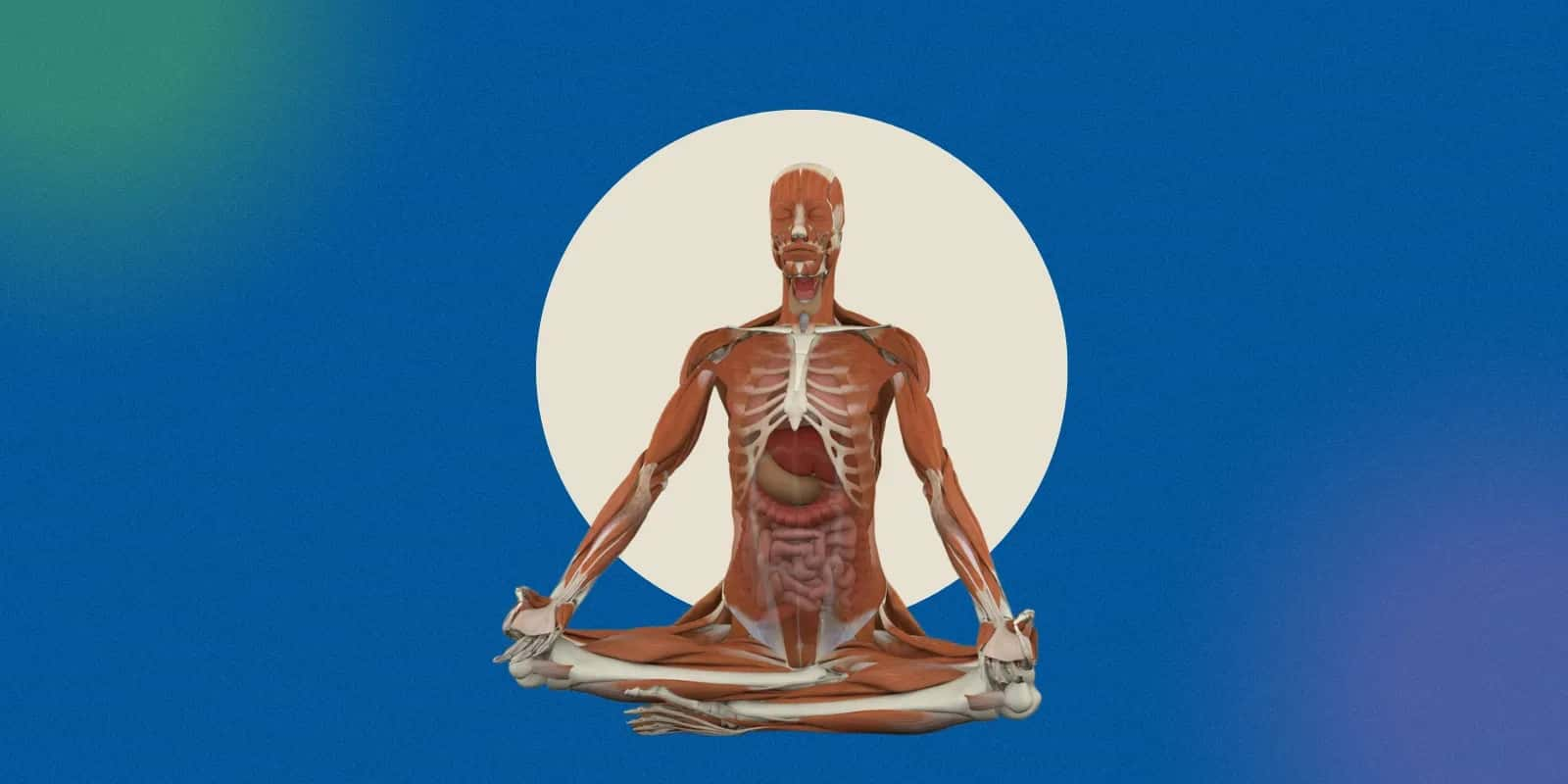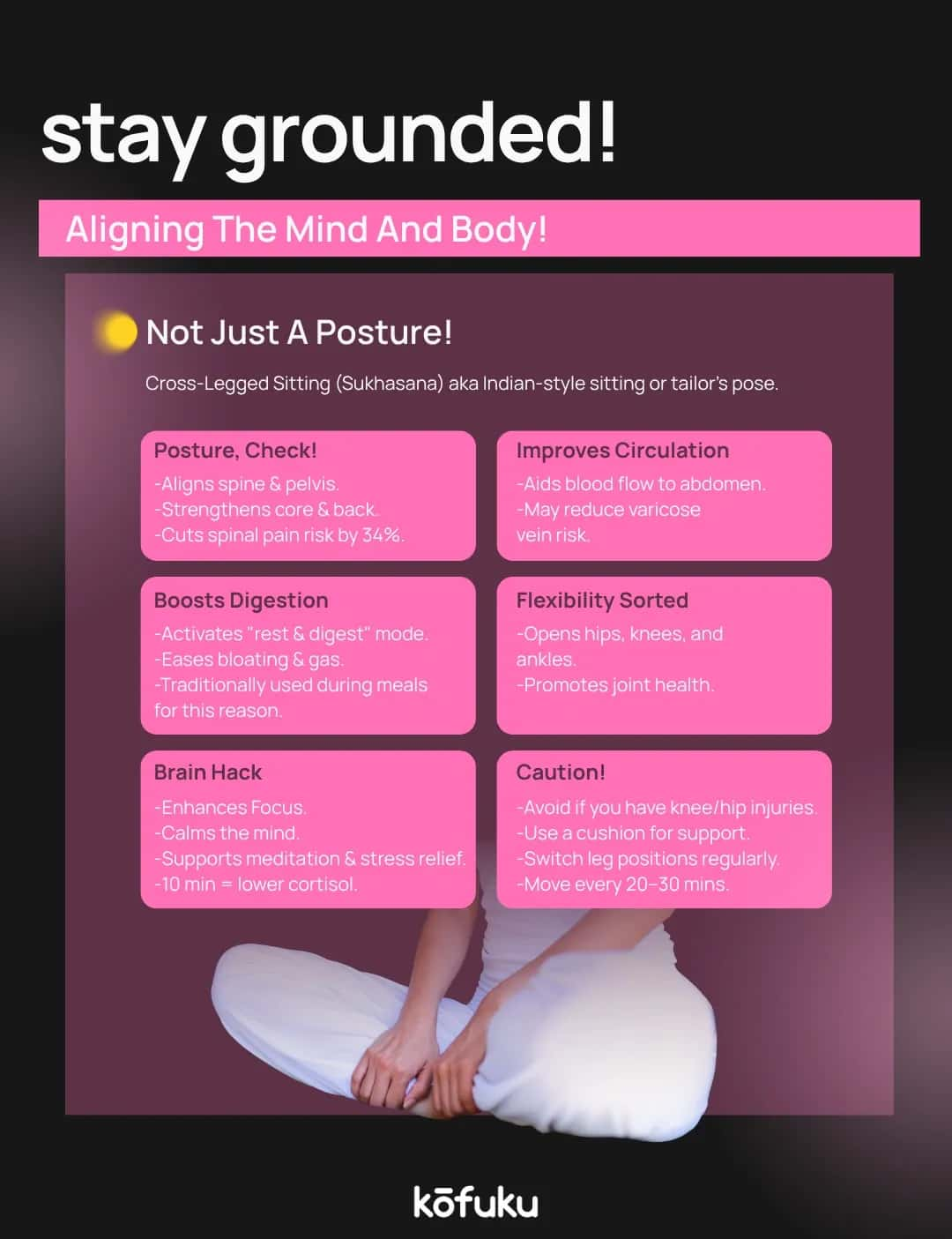Why Sitting Cross-Legged While Eating Can Boost Your Wellness

Introduction
Eating while sitting cross-legged on the floor, often known as sitting in Indian style, is more than just a cultural norm. It is deeply rooted in our culture due to its significant impact on digestion, mindset, posture, and joint health. This article will guide you through how this ancient wisdom can be harnessed to support your overall health.
How the Cross-Legged Position Activates the Vagus Nerve
The vagus nerve connects your brain to your gut, regulating digestion, the stress response, and relaxation. When you sit in Indian style, the slight hip shift and upright spine activate the vagus nerve. This position will help you get into a relaxed, "rest-and-digest" mode, which facilitates the secretion of digestive enzymes while inhibiting the secretion of cortisol, a stress hormone.
In contrast to slumping or eating on the run, sitting cross-legged helps your brain and gut work together for increased absorption, reduced reflux, and a healthier and satisfying dining experience.
Sitting Cross-Legged Is Good for Digestion: How & Why?
Cross-legged position or Indian style sitting aligns your abdominal organs naturally, allowing gravity, rather than slumping or lying reclined, to be the main supporting force for food to pass from the stomach to the intestines. There are no squished, slumping organs getting in the way, with nothing obstructing the natural flow.
Ayurvedic medicine has long praised the value of sitting on the floor, despite people following the Western style of sitting. Also, to support agni (digestive fire), Ayurveda recommends floor seating.
Sitting cross-legged at mealtimes helps limit bloating, trips to the bathroom due to acidity or indigestion, and provides a gentle sense of relief and lightness that lasts long after you've digested your meal.

Conscious Eating with a Grounded Posture
Cross-legged floor eating slows down your rate of eating and heightens your consciousness, making you aware of how much you're consuming and keeping you from overeating consciously.
With no distraction from phones or TVs, your eating experience is enhanced by concentrating on taste, touch, and your feeling of fullness. Indian-position sitting prevents mindless and emotional eating by keeping you present.
As you practice and adapt to sitting in this way and adjusting your body posture at the table, even just once or twice a week, you’ll notice an automatic improvement in portion control, as well as a greater awareness of your hunger cues, and feel calmer during mealtime.
Posture, Core Strength, and Range of Motion: Benefits of Cross-Legged Sitting
Consistently sitting in Indian style gently mobilises and stretches your legs, knees, and ankles. These joints develop flexibility and stability over time, engaging your core and back, resulting in improved posture.
However, people worry about getting hip pain in this posture, which is possible if you have pre-existing conditions or poor posture. When done correctly, over time in a conscious manner, you will improve the state of your joints and likely won’t experience pain.
This posture encourages equal loading in a balanced manner of the lower limb, improving the stability of fascial networks where needed, and promoting better long-term joint and bone health.
Increased Circulation and Heart Function
Sitting cross-legged distributes your weight evenly, with the slight elevation of the legs improving blood flow to the lower body. Practising relaxed, consistent breathing along with this position will enhance your heart functioning and overall circulation.
Indian-style sitting after your meal, in contrast to reclining or lounging, helps reduce the feeling of sluggishness and makes you feel light, purposeful, and free from uneasiness.
When to Sit Indian Style: How Often, How Long, and for Whom?
Frequency: Attempt sitting up on the floor once or twice daily after dining at a table, particularly breakfast or dinner.
Duration: Begin with 10-15 minutes following each meal and increase the duration as you get accustomed.
Support: Place a cushion, a folded blanket, or some support behind your hips if you feel stiffness in your knees or ankles.
Caution for Certain People
Elderly people or those with limited mobility: You can start with very short sessions, limited to 2-3 minutes, and ensure that you have adequate support before you try to sit in Indian style. It is best to do this with supervision.
People with existing hip and/or back issues: Speak to a physiotherapist who knows your case. However, gentle stretches to open the hips, performed before and after meals, would be quite helpful.
If you aren’t able to sit cross-legged physically, you can sit in other ways, such as with one leg tucked, or use a low stool that offers many of the same benefits; just remember to go slowly.

Additional Benefits of Indian Style Sitting
In addition to its digestive and physical benefits, Indian-style sitting promotes mental clarity and emotional grounding. Without screens, apps, and televisions, meals become slow rituals that bring peace instead of mental and physical clutter. In time, this can reduce stress, improve sleep, and enhance your attention span.
In many cultures, eating meals on the floor fosters warmth and bonding with the people you’re sharing the meal with, whether it's your family or friends. These traditions instil a sense of connectivity and mindfulness that is increasingly difficult to achieve in today's modern generation.
Tips for Comfort and Overcoming Common Concerns
- Use a soft surface to sit on, which helps lift your pelvis above your knees and avoid any pain.
- Maintain a straight but relaxed spine, ensuring that there is no tension in your shoulders or jaw.
- Relax and soften your breathing; take a deep inhale and a long exhale.
- If your hips feel tight, take your time to stretch them out with butterfly or figure-four poses.
Addressing the Hip Pain Myth:
- Sitting cross-legged, you may feel stiff if you attempt to sit like that right away, but if you practice enough, flexibility can be achieved easily.
- Use gentler variations of poses if full lotus is not an option
- Remember to stop if you are in pain and take some time to try sitting cross-legged again. Place more support under your hips, and consider sitting in a more comfortable position until your posture improves.
Why Reconnecting With This Ancient Practice Matters Now
In our modern world, where most people use chairs, Indian-style sitting, a part of a more mindful practice, reconnects us to centuries of wisdom concerning health and wellness. It connects digestion, posture, calmness, and social coherence, without the need for technology or incurring any financial cost.
Cross-legged eating may seem like an insignificant practice, but its benefits are substantial, as it aids in digestion improvement, stimulates the vagus nerve, promotes better posture, enhances joint flexibility, and fosters increased mindfulness. It has all the components of a one-stop practice for modern wellness.
By incorporating Indian-style sitting into your routine while having meals, you’re inviting more awareness, nourishment, and calm into your everyday habits.
This simple change comes with benefits, including epiphany-like experiences of gratitude for what you eat, slowing down on mindless eating, and establishing a connection between body and mind for wellness.
Ultimately, this simple change in posture has lasting benefits, establishing a relationship between what you eat and how you live. So, cross your legs, ground yourself, and enjoy your meal.

FAQs
Q. Why is sitting cross-legged good for digestion?
A. Sitting cross-legged compresses the abdomen, activating the digestive organs and the vagus nerve, making digestion easier.
Q. Can sitting on the floor help with posture?
A. Yes, sitting on the floor encourages a straighter spine, engages the core muscles, and is better than sitting in a chair.
Q. Does this eating style aid mindfulness?
A. Eating on the floor slows the pace of eating, allowing you to focus more on your food and helping you minimise distracted or binge eating.
Q. Are there any long-term benefits of this habit?
A. Yes, eating on the floor with practice increases joint mobility and flexibility, improves posture and digestion, and helps you develop a more sustainable and conscious eating habit over time.
Q. Is it advisable for elderly people to sit this way?
A. It may be difficult for some elderly people, especially those with joint issues, so consult a doctor first before making this a habit.

10 Health Benefits of Apple Cider Vinegar You Should Know

10 Monsoon Diseases You Should Be Aware of in India

10 Tips to Clean Your Lungs After Quitting Smoking

11 Things To Know About Birth Control and Antidepressants

12 Unusual Symptoms of Diabetes


